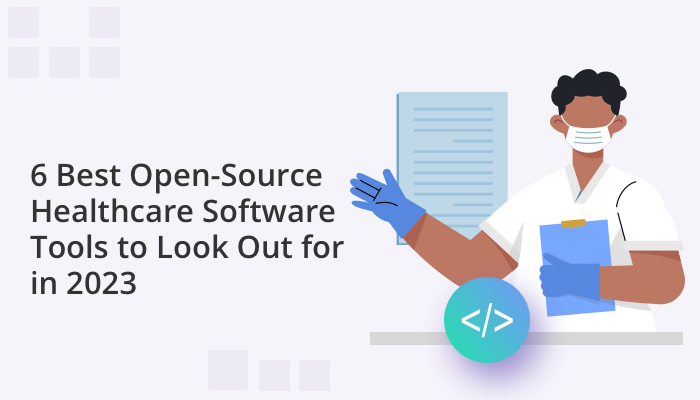
Today healthcare organizations rely on a range of digital software tools to store and organize patient data, manage hospital workflows and resources, and provide online communication. Instead of opting for traditional, vendor-licensed, and proprietary healthcare digital solutions, many healthcare organizations are increasingly exploring the world of open source telehealth software. For example, during the pandemic when healthcare providers needed to consult remotely with patients and colleagues, more and more developers opted to use an open source telehealth chat SDK and API to build robust online communication tools. With a lower cost base and larger scope to be customized to meet the specific needs of the end user, open source software had become an attractive option.
This article will explore some of the key benefits of open source software as well highlight 6 of the best open source telehealth tools available in 2023.
Table of Contents
What is open source software?
Open source software is software that is distributed with its source code available for anyone to modify and redistribute. This allows users to view and alter the source code, as well as redistribute copies with or without changes. Open source software is usually developed as a public collaboration and made freely available.
Open source telehealth software, which is generally offered free to anyone to use, includes a variety of programs and applications aimed at making healthcare more efficient and available to people all over the world. Common examples of open source telehealth software include video conferencing or video calling solutions, electronic medical records systems, medical imaging and analysis tools, health information systems, and patient information systems.
What are the benefits of open source telehealth software?
For many, open source paves the path to faster IT solutions in healthcare by offering interoperability and security solutions while simultaneously reducing the operative cost with improved user experience. Let’s look at some of these benefits in greater detail.
1. Cost Effectiveness: Without doubt, one of the main advantages of open source telehealth software is its cost. Open-source code is usually offered free or has low costs compared to the proprietary alternatives available in the market. Hence healthcare organizations can make substantial savings.
2. Security: Open source software is often designed with security as a priority, minimizing the risk of data breaches and providing organizations with peace of mind. Concerns for security are paramount in healthcare. Legislation like the Health Insurance Portability and Accountability Act (HIPAA), which governs the healthcare industry in the USA, compels healthcare professionals to use software that safeguards Protected Health Information (PHI). Open-source software can provide better security compared to proprietary software as the code is open and can be reviewed by any user and modified to offer additional security features.
3. Customization: Open source software can be customized to fit the specific needs of a healthcare organization and its users, allowing for greater flexibility in deploying the right system for the right job. Of course, you can sometimes customize proprietary software, but the proprietor will determine which aspects are customizable and will charge you for this service. Generally customization charges become pretty expensive in the case of proprietary software.
4. Innovation & Quality: Open source software encourages collaboration between healthcare organizations and developers, allowing for more rapid development and innovation. Many open-source software projects have vibrant communities of users and developers who can help with technical issues and provide advice on how to get the most out of the software. The large number of developers contributing to its development means that open source software is generally of higher quality than proprietary software.
5. Scalable: Open source software can easily be scaled up or down as needed, allowing organizations to respond quickly to changing demands or business needs without needing to invest in new software or hardware.
In sum then, with open source software, hospitals can employ the latest technologies in their medical practice at standardized cost without compromising on security and flexibility.
Now that we’ve explored some of the benefits of open source healthcare software, let’s look at some of the best options available for 2023. One advantage they all share in common is their affordability, as they are all free to use
OpenEMR
OpenEMR is an open source electronic medical record and practice management system used by medical professionals around the world. It provides a comprehensive set of features including scheduling, patient tracking, electronic medical records, prescriptions, billing, and much more. OpenEMR is designed to meet the needs of small to medium sized medical practices and can be installed on a server or hosted in the cloud.
Main Advantages:
- OpenEMR is designed to be user-friendly and can be easily customized to fit the needs of individual practices.
- It includes comprehensive features such as electronic health records, scheduling, billing, prescriptions, and more.
- OpenEMR is HIPAA compliant and includes enhanced security features.
- It can easily be scaled up or down to fit the needs of a practice.
- The system also runs on multiple platforms, notably OpenEMR is mobile friendly and can be accessed from any device.
- OpenEMR is able to integrate with other systems, making it easier to exchange data with other providers.
Q-Consultation Lite
Q-Consultation Lite by QuickBlox provides open source telehealth for video calling and chat. It is supported by the Q-Consultation API, which assists developers with fast integration. The software allows healthcare professionals to organize private video consultations with patients via virtual meeting rooms. Waiting patients can be held in a virtual queue. The software provides high-quality video calling and in-app messaging making it a great tool to enhance patient-doctor communications, and manage internal staff communication as well. The software also allows the user to create patient profiles, record video appointments, and make and store notes that can be synced with the company’s EHR system.
Particularly innovative, Q-Consultation Lite has now been integrated with OpenAI to enable a range of AI powered features including an AI assistant that can provide accurate data during the consultation, a transcription service for transcribing recorded video sessions as well as summarizing and creating actions points from the transcription, and smart recommendations, a features that intelligently matches patients with doctors based on skills sets and needs.
Main Advantages:
- It is a web application adaptable to mobile web browsers, which means it can be used across platforms.
- The source code works on top of the QuickBlox back-end platform which is secure and robust.
- If hosted within the QuickBlox HIPAA cloud or your own private cloud, the software is HIPAA compliant and can be offered with a BAA.
- Designed for interoperability, the source code can be plugged into an existing healthcare website or app.
- As a white label solution, its source code can be customized to add a number of features to meet specific use case demands.
- It is feature rich. Along with video consultation, the app offers instant messaging, file sharing, note-taking, and a ton of user management features.
- Integrated with OpenAI for cutting edge features.
Find out more about: Product Update: Open Source Video Chat Integrated with AI
OpenMRS
OpenMRS is an open-source electronic medical record system platform that is designed to manage the healthcare information of patients in low- and middle-income countries. It is a tool for capturing, storing, managing, and sharing medical information across multiple sites in a distributed network. OpenMRS provides healthcare providers with a comprehensive set of features for managing patient care needs.
Main Advantages:
- With the aim of making this software as accessible as possible to developing countries, it has a modular architecture that allows for customizable functions without the need to modify the core code.
- OpenMRS is built as a platform which makes it highly flexible and customizable. It is also designed to scale with an organization’s growth.
- The platform is built with multiple levels of authentication and encryption.
- OpenMRS is designed to be accessible from any device and platform.
- Practitioners can use OpenMRS to automate many aspects of patient record keeping, such as medication refills and appointment reminders.
- OpenMRS is designed to be interoperable with other medical record systems.
Open Hospital
Open Hospital (OH) is an open-source electronic medical record (EMR) system designed to meet the needs of low-resource settings. It is a comprehensive system that includes a web-based patient registration system, an electronic medical record (EMR) system, an appointment scheduler, a laboratory information system, a pharmacy system, a billing system, and a report generator. OH is designed to be easy to use, intuitive, and secure for healthcare workers, but also to be flexible enough to adapt to different settings and needs. It is free to use and is available in multiple languages.
Main Advantages:
- OH automates administrative tasks such as scheduling, prescriptions management, and billing, making the daily operations of the healthcare facility more efficient.
- It provides effective patient portals to enhance communication and patient engagement.
- The system uses advanced encryption methods to ensure patient data is kept safe and secure, helping to protect against breaches and data theft.
HospitalRun
Hospital Run is an open source software platform that helps hospitals and healthcare organizations manage their operations. It is designed to help streamline processes, reduce costs, and improve patient care. It includes features such as patient registration, scheduling, billing, medical records, and more.It is designed to be used by both small and large healthcare organizations, and is available in both cloud-based and on-premise versions.
Main Advantages:
- With the platform designed to work offline, HospitalRun is one of the best choices for clinics situated in remote or rural areas where internet connectivity is either weak or completely unavailable.
- The platform’s mobile app helps clinicians access patient records and other information on the go, allowing for better care coordination and faster response times.
- HospitalRun helps streamline workflows by automating administrative tasks, such as scheduling and billing, to help reduce errors and improve hospital efficiency.
GNU Health
GNU Health is a free and open source health and hospital information system. It is designed to be used in a variety of settings, from small clinics to large hospitals, and provides a comprehensive set of features for managing patient records, scheduling appointments, tracking medical treatments, and more. GNU Health is developed by the Free Software Foundation and is licensed under the GNU General Public License.
Main Advantages:
- GNU Health is highly customizable and can be adapted to meet the needs of any healthcare organization. It can be used to manage patient records, appointments, billing, and more.
- It includes built-in security features to protect patient data and ensure HIPAA compliance.
- Designed to be scalable, GNU Health can easily grow with your organization as your needs change.
- GNU Health UI and UX is intuitive and user-friendly, so it’s easy for healthcare professionals to learn and use.
- The platform benefits from being interoperable with other healthcare systems, so data can be easily shared between different systems.
Summing up
This essay examined six of the best open source telehealth tools in 2023. These include OpenEMR, Q-Consultation Lite, OpenMRS, Open Hospital, and HospitalRun, and GNU Health. All of these open source tools provide important benefits for healthcare professionals, including improved patient care, more efficient record-keeping, and better communication. They are ideal for healthcare organizations looking to save money and improve efficiency.
If you have a particular need for adding communication software to your existing healthcare platform, then you should consider Q-Consultation Lite. With virtual meeting rooms, video calling, chat, and a developer friendly API, this open source telehealth solution offers an extremely versatile and cost efficient option for countless healthcare organizations. Contact us now to find out more.
Find out more about: Announcing the Launch of Q-Consultation Lite! Free, Open Source Software








